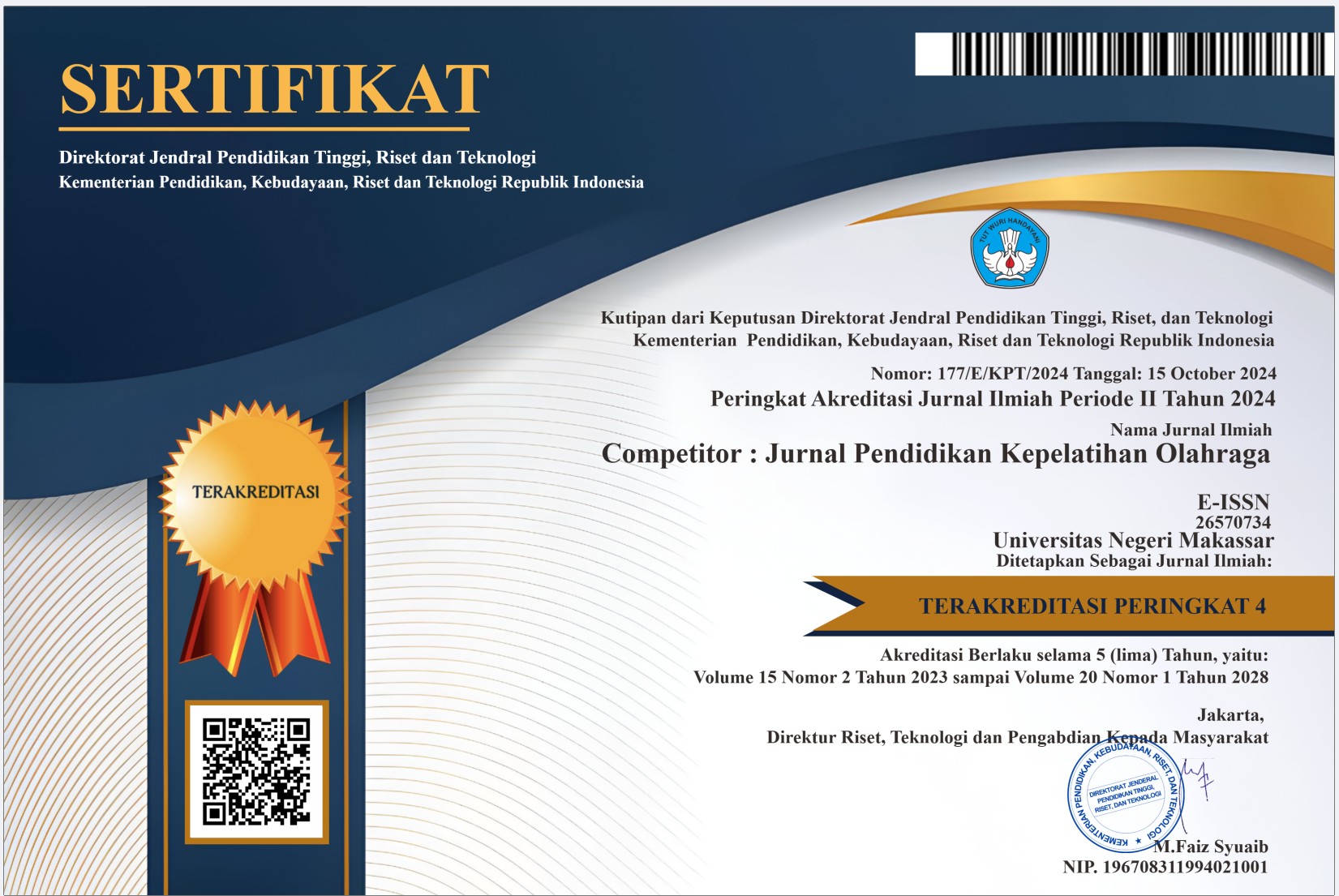Dribbling Speed In Basketball Games Reviewed From Students' Anthropometrics
DOI:
https://doi.org/10.26858/cjpko.v17i2.73573Keywords:
Speed, Dribbling, Basketball, Anthropometry, Students.Abstract
This study aims to determine the effect of anthropometric factors on the dribbling speed of students of SMPN 3 Bontomarannu at various grade levels. This study used a quantitative method with a descriptive correlational design. The subjects of the study were 178 students, consisting of 55 7th-grade students (average age 12.29 years), 58 8th-grade students (average age 13.38 years), and 65 9th-grade students (average age 14.14 years). The anthropometric variables measured included body weight, height, leg length, arm length, waist circumference, arm circumference, palm length, palm width, span length, and foot length. Dribbling speed was measured using a dribbling test with recording travel time. Data analysis used multiple regression analysis with a significance level of α = 0.05. The results showed differences in the influence of anthropometrics at each grade level. In grade 7 students, there was no significant effect of anthropometric factors on dribbling speed (R² = 0.126; p > 0.05 for all variables). Grade 8 students also showed insignificant results, even though the correlation value was higher (R = 0.410; R² = 0.168; p > 0.05 for all variables). In contrast, in grade 9 students, a significant effect was found with a strong model (R = 0.627; R² = 0.393). Three anthropometric variables had a significant effect: height had a positive effect (β = 0.164; p = 0.018), leg length had a negative effect (β = -0.204; p = 0.000), and palm width had a negative effect (β = -1.350; p = 0.015). The average dribbling time decreased with increasing grade level, namely 21.57 seconds (grade 7), 20.27 seconds (grade 8), and 17.02 seconds (grade 9). The influence of anthropometric factors on dribbling speed varies based on the level of student maturity. Anthropometric factors did not have a significant effect on students in grades 7 and 8, but had a significant effect on students in grade 9. This shows that with increasing age and physical maturity, anthropometric factors begin to play a role as determinants of dribbling speed. Optimal height, proportional leg length, and appropriate palm width are important factors in the dribbling ability of more mature students.
References
Abdussamad, H. Z. (2021). Qualitative Research Methods (Patta Rapanna, Ed.; First). Syakir Media Press.
Adam Mappaompo, M., Aprilo, I., Elisano Arfanda, P., & Arga. (2024). Shooting Accuracy Of Sports Coaching Education Students: Goaling Game Practice. Indonesian Journal of Research and Educational Review, 3(3), 204–210. https://doi.org/10.51574/ijrer.v3i3.1995
Arga, Arkanul Arba, M., Rahmatullah, W., Nurhalizah Mutia Aulria, S., & Tandi Rerung, C. (2024). Football Dribbling Speed Reviewed From Running Speed. KING: Knowledge Integrated Networking for Global Sport and Health, 1, 64–68. https://jurnal.sainsglobal.com/index.php/king
Arga. (2025). The Effect of Leg Raise Exercise on the Abdominal Muscle Strength of PKO UPRI Students. Journal of Sports Coaching Education (PEJUANG), 1(1), 18–23.
Brown, M., & White, J. (2022). Longitudinal analysis of anthropometric development and basketball dribbling performance in middle school students. Journal of Youth Sports Development, 15(3), 234-248.
Chen, L., Zhang, Y., & Liu, M. (2021). Effectiveness of anthropometric-based dribbling training programs in adolescent basketball players. Sports Science and Medicine, 12(4), 445-460.
Gonzalez, R., Martinez, A., & Silva, P. (2021). Biomechanical analysis of basketball dribbling: The role of arm length and hand size. International Journal of Sports Biomechanics, 8(2), 178-192.
Kim, J., Lee, S., & Choi, M. (2021). Impact of growth-related anthropometric changes on dribbling biomechanics in Korean middle school students. Korean Journal of Sport Science, 32(4), 512-527.
Kim, S., & Park, H. (2023). Comparative study of anthropometric factors and dribbling performance between Korean and American adolescent basketball players. Asian Journal of Sports Science, 18(1), 67-82.
Lee, K., Tan, C., Wong, L., & Nguyen, H. (2022). Cross-sectional analysis of anthropometric characteristics and dribbling ability in Southeast Asian middle school students. Southeast Asian Journal of Sports Medicine, 7(3), 156-171.
Lopez, M., Rodriguez, C., & Fernandez, L. (2023). Relationship between anthropometrics, muscle strength, and dribbling performance in adolescent basketball players. Sports Performance Research, 9(2), 298-315.
Martinez, J., & Ramirez, S. (2023). Effects of unbalanced anthropometric development on basketball dribbling skills during adolescent growth spurts. Developmental Sports Psychology, 11(1), 89-104.
Rodriguez, A., Smith, B., & Johnson, C. (2022). Anthropometric influences on dribbling speed in youth basketball players aged 13-15 years. Journal of Sports Performance, 14(2), 123-137.
Rodriguez, P., & Fernandez, M. (2023). Meta-analysis of anthropometric factors and basketball performance in adolescents: A systematic review of 30 studies. Sports Medicine Review, 28(3), 445-462.
Santos, F. G. D., Silva, R. M., & Oliveira, P. T. (2020). Kontrolle Ball Test: A valid and reliable instrument for assessing basketball dribbling speed. Brazilian Journal of Sports Science, 16(4), 278-291.
Suwardi, Adnan Hudain, M., Fahrizal, Adil, A., Rachmat Kasmad, M., & Arga. (2024). Structured Training at SDN Paccinangan on Basketball Dribbling. LITERA ABDI: Journal of Community Service, 2(1), 80–87. https://doi.org/10.59734
Taylor, R., Anderson, K., & Thompson, M. (2023). Cross-cultural comparison of anthropometric characteristics and dribbling performance in five countries. International Sports Research, 21(1), 34-51.
Thompson, D., & Garcia, M. (2021). Two-year longitudinal study of anthropometric development and basketball skills in middle school students. Adolescent Sports Development, 13(4), 201-218.
Wang, X., Liu, Y., & Chen, Z. (2023). Compensatory training strategies for anthropometric limitations in basketball dribbling performance. Applied Sports Science, 19(3), 345-362.
Wilson, P., Davis, S., & Miller, T. (2022). Meta-analysis of 50 studies examining anthropometric factors and basketball dribbling performance. Sports Science Meta-Analysis, 6(2), 112-128.
Yamamoto, T., Suzuki, K., & Tanaka, H. (2021). Effects of anthropometric ratios on dribbling speed and ball control in Japanese middle school basketball players. Japanese Journal of Sports Science, 25(3), 189-205.
Downloads
Published
Issue
Section
License
Copyright (c) 2025 Marlan Afif, Suwardi Suwardi, Muh. Adnan Hudain, Andi Ridwan, Muhammad Ishak (Author)

This work is licensed under a Creative Commons Attribution 4.0 International License.





















